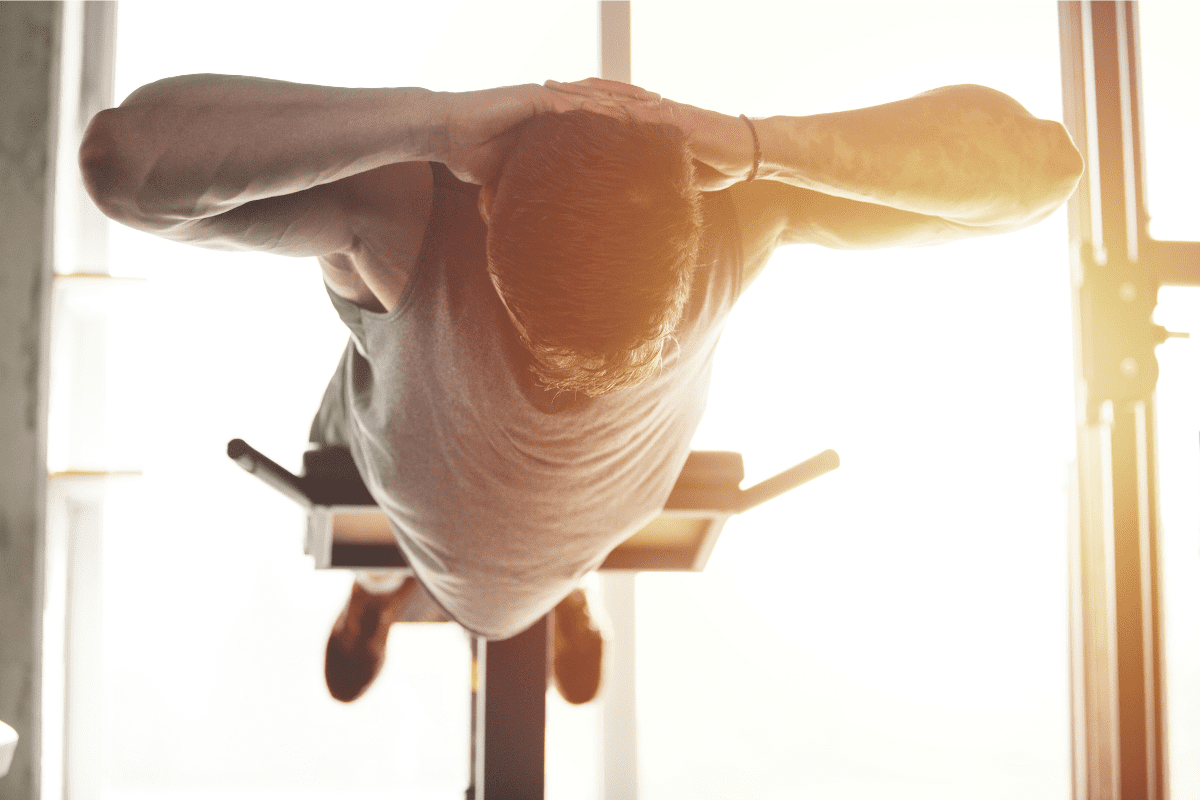The 12 Best Glute Ham Raise Alternatives (2024)
Glute Ham Raises are an excellent exercise for building posterior chain strength. They’re a staple in my strength training programming because of their simplicity and effectiveness.
However, sometimes you may need an alternative for Glute Ham Raises. Maybe you don’t have a Glute Ham Machine or maybe you’re just looking to add some variety to your workouts.
I’ve been a College Strength Coach for 20 years and utilizing exercise substitutions is something I have to do on a daily basis. In this article, I will share with you my 12 favorite Glute Ham Raise alternatives.
Glute Ham Raise Alternatives
I’ve tried to make this list of alternatives as diverse as possible. There are exercises that use a barbell, dumbbells and even no equipment at all.
Hopefully, no matter what equipment you have or what your lifting experience is – one of these alternatives can serve as a replacement for Glute Ham Raises.
Hyperextensions
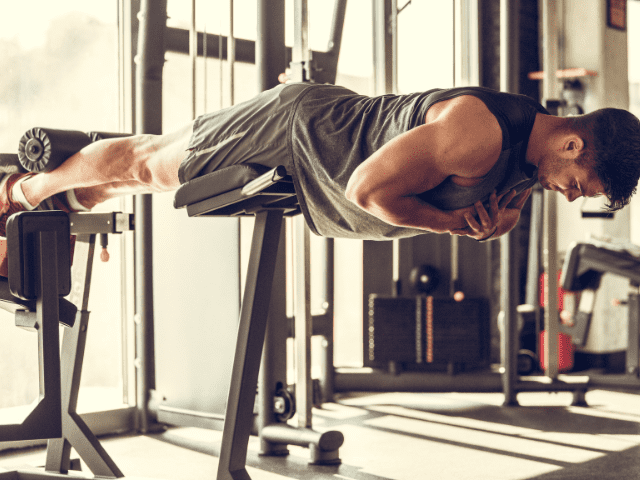
Hyperextensions are literally Glute Ham Raises minus the leg curl. If you’re not yet able to do a full Glute Ham Raise, then Hyperextensions may be a good substitute to continue building strength.
Step-by-Step Instruction
- Position yourself on the hyperextension bench with your thighs against the pad and feet securely under the footplate.
- Cross your arms over your chest or place hands behind your head. Ensure your spine is neutral.
- Begin the exercise by bending at the hips, lowering your upper body toward the floor.
- Lower yourself as far as comfortable while maintaining a straight back.
- Lift your torso by extending your hips until your body forms a straight line from head to heels.
- Squeeze your glutes at the top of the movement, ensuring your back remains straight, not hyperextended.
- Slowly lower back to the starting position
Coaching Points
Hyperextensions are surprisingly easy to mess up. One of the easiest ways to make a mistake is going down too fast and “whipping” yourself back to the starting position.
It is important for the lifter to maintain a neutral spine, maintaining tension in the abdomen and upper back. Remember to breathe in and hold the breath during eccentric (lowering your body) and breathe out as you perform the concentric movement (bringing your body back up).
Nordic Hamstring Curls
Nordic Hamstring Curls are basically half of a Glute Ham Raise.
What makes them a particularly good alternative for the full movement is you don’t need a Glute Ham Raise machine to do them. All you need is a partner and a desire to really challenge your hamstrings!
How To
- Kneel on a padded surface for comfort, with your feet anchored under the bar, partner’s hands, or within the designated hooks of a Nordic hamstring machine if available.
- Begin with your body in a tall kneeling position, hips extended, and your hands crossed at your chest or by your sides, depending on your preference.
- Tighten your core to prepare for the movement. Keep your hips extended; avoid hip flexion as you lower down.
- Slowly lean forward, leading with your hips, not your shoulders. The goal is to maintain a straight line from your knees to your shoulders.
- Lower yourself as slowly as possible, using your hamstrings to control the descent for as long as you can. Resist the fall using your hamstrings until you can no longer hold it.
- Place your hands in front of you to catch yourself as you reach the limit of your hamstring flexibility or strength.
- Use your arms to push yourself back up to the starting position if you can’t use your hamstrings alone for the ascent.
Coaching Points
Really focus on keeping your hips forward and your body in a straight line from your knees to your shoulders.
Only push hard enough off the floor to allow your hamstrings to do most of the work. How much push is that? You’ll know.
Barbell Romanian Deadlift (RDL)
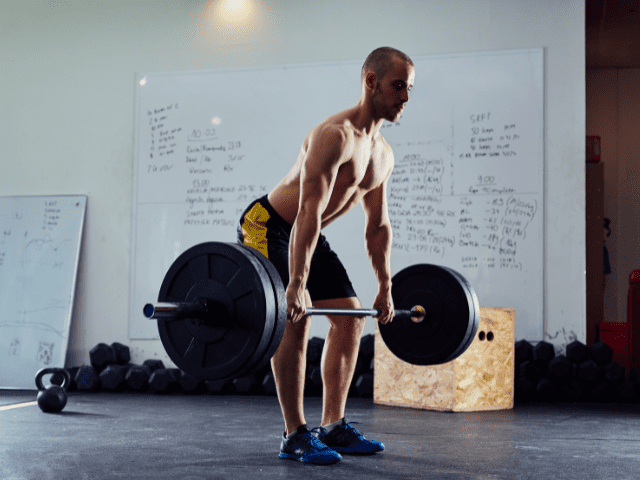
There are few exercises that will come close to producing the same type of development for both the erectors and the hamstrings. One movement that will – Romanian Deadlifts. If you don’t have a glute ham machine, this would be my first suggestion to replace Glute Ham Raises.
How To
- Begin by standing upright, holding a barbell in front of you with an overhand grip.
- Feet should be hip-width apart with a slight bend in the knees.
- Keeping a neutral spine and your chest up, hinge at the hips, pushing them backward.
- Allow the barbell to slide down close to your legs. Your back remains straight throughout.
- Lower the bar until you feel a strong stretch in your hamstrings or it reaches mid-shin level, whichever comes first.
- Engage your hamstrings and glutes, then reverse the motion, bringing the barbell back to the starting position.
Coaching Points
The ‘depth’ that each person gets will be different and absolutely solely dependent upon hamstring flexibility.
Do NOT try to ‘reach’ the barbell toward the ground because you believe the plates should touch the floor. If you have tight hamstrings you may be doing well to get the bar to mid-shin.
Dumbbell RDL
Dumbbell RDL is another great exercise for the posterior chain that uses dumbbells instead of a barbell.
Step-by-Step Instruction
- Choose a pair of dumbbells and hold them in front of you with palms facing your thighs.
- Stand with your feet hip-width apart, maintaining a slight bend in the knees.
- Begin by hinging at your hips, pushing them backward, and lowering the dumbbells along your shins.
- Keep your back straight and chest up, ensuring the dumbbells stay close to your legs throughout the descent.
- Once you feel a stretch in your hamstrings or the dumbbells reach mid-shin level, reverse the motion.
- Engage your hamstrings and glutes to pull yourself back to the starting position.
Coaching Points
During Dumbbell RDLs, it is important for the lifter to maintain a neutral spine, maintaining tension in the abdomen and upper back.
Single Leg Dumbbell RDL
Single Leg Dumbbell RDL is a Glute Ham Raise alternative that also incorporates balance, stability and coordination on top of developing the posterior chain.
Step-by-Step Instruction
- Stand on one leg, holding the weight in the opposite hand.
- Keeping a slight bend in the standing leg, hinge forward at the hip while extending the free leg straight behind you.
- Lower the weight towards the ground while maintaining a straight line from head to extended foot.
- Pause briefly at the bottom without rounding your back.
- Engage your hamstring and glute to return to the starting position, maintaining balance.
Coaching Points
Do not let the weight drift over the midline when doing Single Leg RDLs. You will train for more structural stability if you keep the dumbbell in front of the down leg.
Maintain the arch of the foot. When performing single-leg movements, it is very important to maintain balance to yield all the benefits of single-leg exercises.
It is important for the lifter to maintain a neutral spine, maintaining tension in the abdomen and upper back.
Kettlebell Swing

Kettlebell Swing is a dynamic, beginner-friendly hip hinge movement that can add some explosiveness and power into your workout.
Step-by-Step Instruction
- Stand with feet shoulder-width apart, holding the kettlebell with both hands in front of you.
- Push your hips back, bending slightly at the knees, and lowering the kettlebell between your legs.
- Powerfully extend your hips and knees, swinging the kettlebell forward and upward to chest height.
- At the peak, your body should be in a straight line from head to heels.
- Allow the kettlebell to swing back down, hinging at the hips, and preparing for the next repetition.
Coaching Points
The Kettlebell Swing is a great movement to train rapid hip extension and flexion. Remember to always keep a neutral spine (DO NOT ROUND YOUR BACK).
Choosing the proper kettlebell weight is important. Heavier is not always better. Because of the rapid nature of the kettlebell swing, the emphasis should be on velocity, speed, and power.
Reverse Hyper
Reverse Hyperextensions won’t target the hamstrings in the same way as a Glute Ham Raise, but it’s an excellent glute and low back developer.
How To
- Grab the handles of the Reverse Hyper Machine and lay your torso across the platform.
- Set up your legs/feet with the resistance (will differ depending upon the machine)
- Keeping your legs straight, raise them up until they are parallel to the floor.
- Squeeze the glutes at the top and then lower the legs back down under control.
Coaching Points
There are specific Reverse Hyper machines. These machines allow you to add weight and lift the legs with added resistance.
If you don’t have access to a Reverse Hyper machine, you can use a regular Glute Ham Machine to do Reverse Hypers. To add resistance, you can hold a medicine ball in between your feet.
Banded Good Mornings
I typically avoid Barbell Good Mornings, but Good Mornings with a resistance band is a great movement prep exercise that can be included in a warm-up or as extra volume work at the end of a workout.
Step-by-Step Instructions
- Stand on a resistance band and pull it up over the head and across the back of the shoulders.
- Stand tall with feet hip-width apart, hands holding and securing the band in place.
- Put a slight bend in the knee and pull the shoulder blades back.
- Now, hinge at the hips by pushing the hips back and bending at the waist. Push your knees out slightly as you descend.
- Keep the back slightly arched throughout the movement.
- Continue the hinge until you feel a stretch in the hamstrings.
- Stand back up tall and push the hips forward to the starting position.
Coaching Points
Banded Good Mornings can serve as a warm-up movement or as a strength-building exercise, usually as part of a circuit.
Listen to your body. Depending on your hamstring (and sometimes glute or low back) flexibility, you may be able to lower down quite far or not very much at all. The key is to move just to the edge of your range of motion. Don’t try to force anything.
Stability Ball Leg Curl
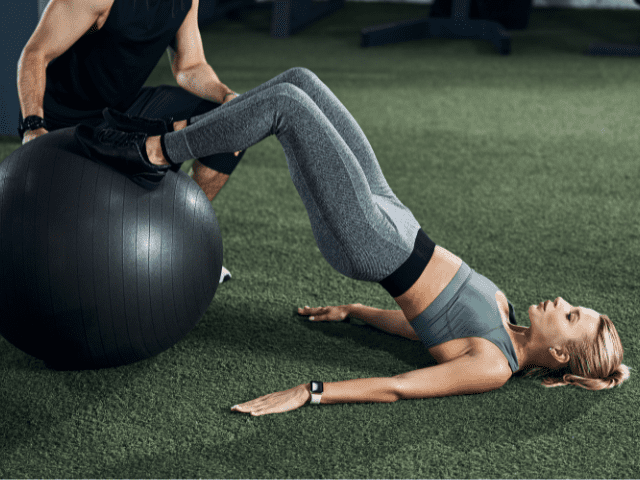
If you need a Glute Ham Raise alternative for your hamstrings, then consider a Stability Ball Leg Curl. Harder than they look, Stability Ball Leg Curls are one of the best hamstring movements you can do.
Step-by-Step Instruction
- Lie down on your back and almost fully extend your legs.
- Place your heels on the ball.
- Drive your elbows into the floor and keep your abdomen tight. Drive your heels into the ball.
- Drive your hips to the ceiling and engage your glutes.
- Keeping your core nice and tight, pull the ball under your butt as much as possible.
- At the top of this movement, keep the glutes engaged and core tight.
- Engaging the hamstrings, roll the ball back until your body is almost fully straight.
Coaching Points
Make sure the stability ball is properly inflated when doing Stability Ball Leg Curls. If it is not, the muscles we are training will not engage fully.
Remember to always squeeze with the glutes and actively engage the hamstrings. Do not round the back and push your belly to the sky. Keep the anterior core locked in throughout the movement.
Glute Bridge
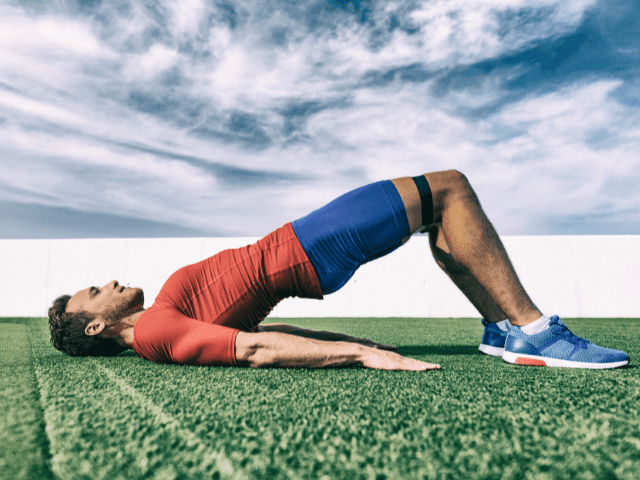
A bodyweight Glute Bridge isn’t the strength-building movement that a Glute Ham Raise is, but it’s an effective movement that is great for a warm-up.
Step-by-Step Instructions
- Start by laying on your back on the ground.
- Bend both knees to about a 90-degree angle and place both feet flat on the floor.
- Begin the rep by driving your hips up into the air. Try to attain a straight line from the shoulders through the hips and knees.
- Squeeze the glutes at the top of the rep and then lower back down to the starting position.
Coaching Points
As you raise the hips up, try to drive the knees slightly forward. This can help with getting a strong glute contraction and a full extension of the hips. Don’t rush through Glute Bridges. Make sure to pause and squeeze at the top of each rep.
Floor Slider Leg Curl
Floor Slider Leg Curls won’t work the low back like a Glute Ham Raise, but they are a tremendous exercise for targeting the hamstrings. They require minimal equipment and they are WAY harder than they look.
Step-by-Step Instruction
- Lie down on your back and bend your knees at about 90 degrees.
- Place the sliders under the heels of your feet.
- Drive your elbows into the floor and keep your abdomen tight.
- Drive your hips to the ceiling and engage your glutes.
- Keeping your core nice and tight, slowly slide your heels away from your body until your knees are almost fully extended.
- At the end range of this movement, your body should be straight, hips up, and core engaged.
- Engaging the hamstrings, pull your heels back to the starting position and squeeze the glutes to resume the starting position.
Coaching Points
One of the most important points about this movement is the surface you are sliding on and the type of slider you’re using.
The furniture slider should freely move with little resistance, I would say carpet is ideal if available. If there is resistance, this may affect your technique and coordination.
Remember to always squeeze with the glutes and actively engage the hamstrings. Do not round the back and push your belly to the sky. Keep the anterior core locked in throughout Floor Slider Leg Curls.
Supermans
The final exercise on this list of Glute Ham Raise alternatives is Supermans.
Supermans are great because they do not need any equipment at all. While they won’t be nearly as challenging as a Glute Ham Raise, they work perfectly in a warm-up or in a bodyweight workout if you’re limited on equipment.
Step-by-Step Instructions
- Lay on your stomach with arms stretched out overhead.
- Contract the low back and glutes and raise the chest, arms and legs (thighs) off the ground.
- Squeeze and hold for a one count and then lower back down to the ground.
Coaching Points
Take your time and don’t rush through the movement. Squeeze the top of each rep and lower yourself back to the ground under control. Too often I see athletes just quickly go through the motions with Supermans – focus on each rep to get the max benefit.

Need a Training Program?
Coach Horton has 20 years of experience training elite level athletes at schools like the University of Tennessee and Georgia Tech. He has also written plenty of programs for other coaches and friends and family.
So, whether you need a program to improve your performance in your sport or you just want to look good at the beach, there is a program designed just for you.
Final Thoughts
Glute Ham Raises are an amazing exercise and one of my favorite posterior chain movements. However, I also understand that there are situations where you simply can’t do Glute Ham Raises.
Glute Ham machines are pretty big and pretty expensive. If you’re working out at your home, chances are you simply don’t have one of these machines available to you. I’ve even been in commercial gyms that didn’t have a Glute Ham Raise machine.
Hopefully, this list of Glute Ham Raise alternatives has helped you figure out a different movement that you can use as a substitute.

